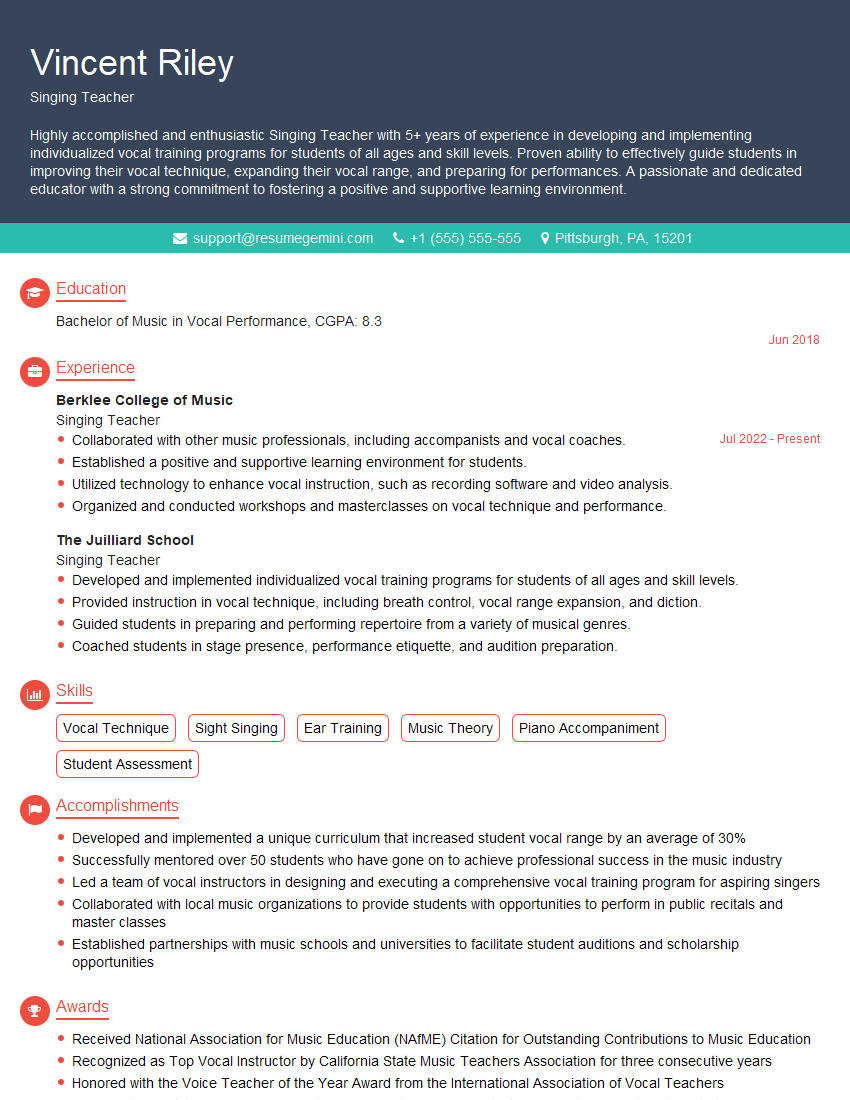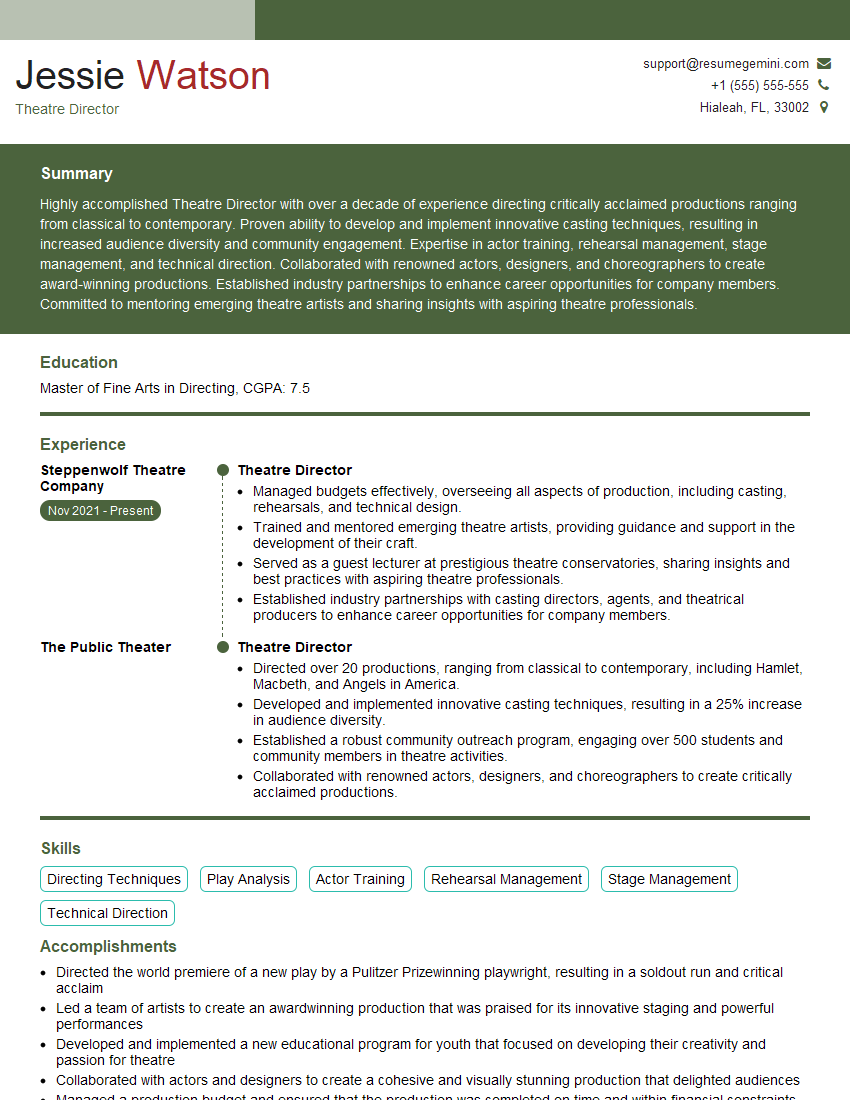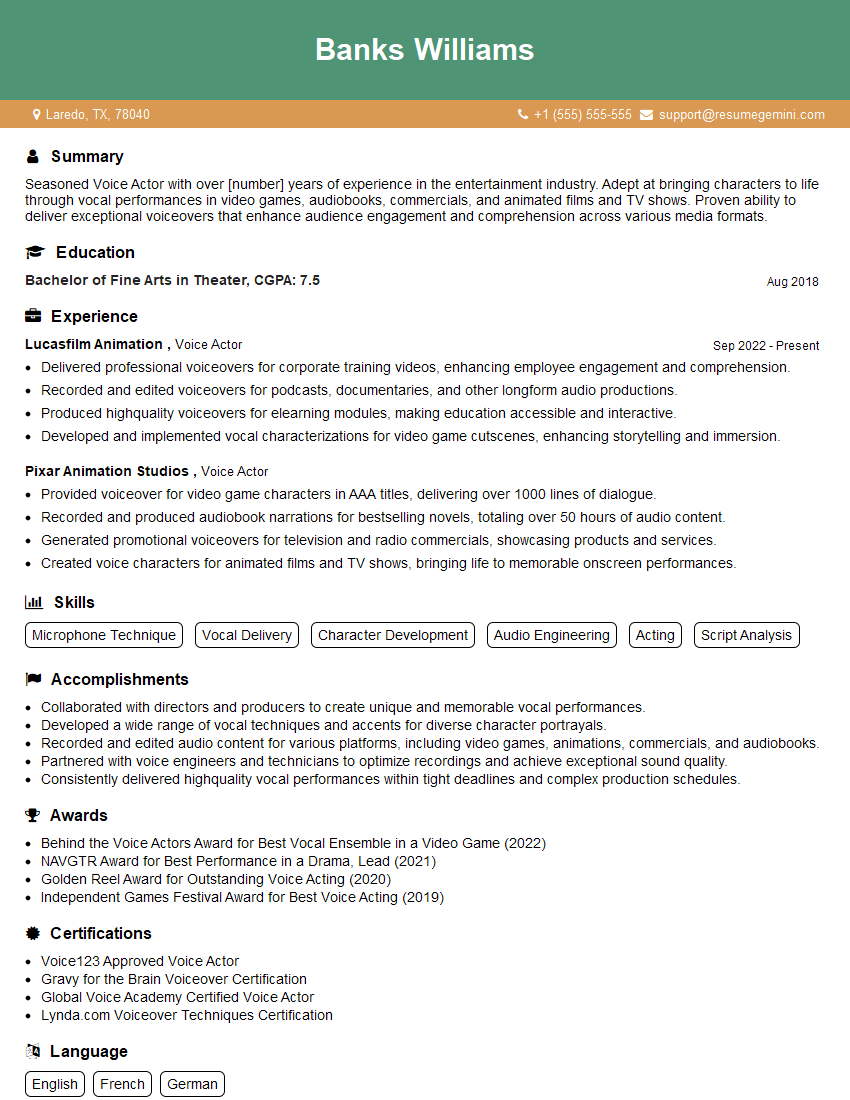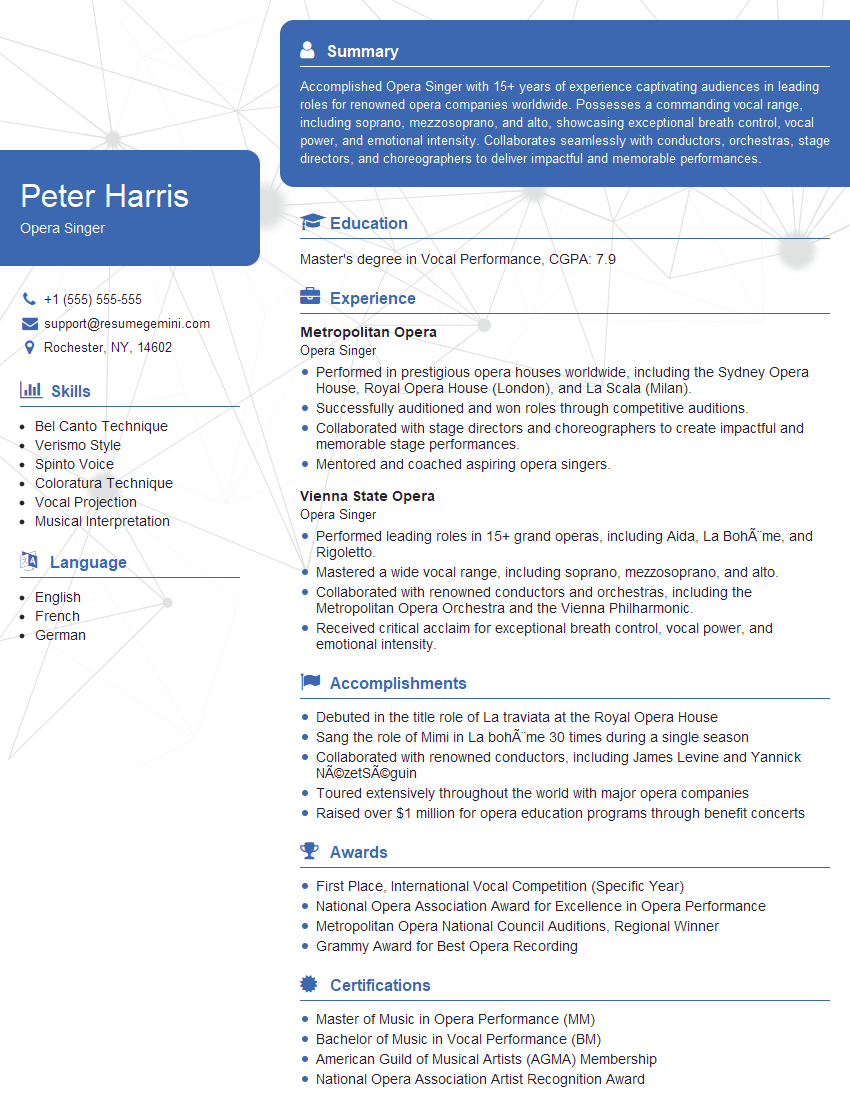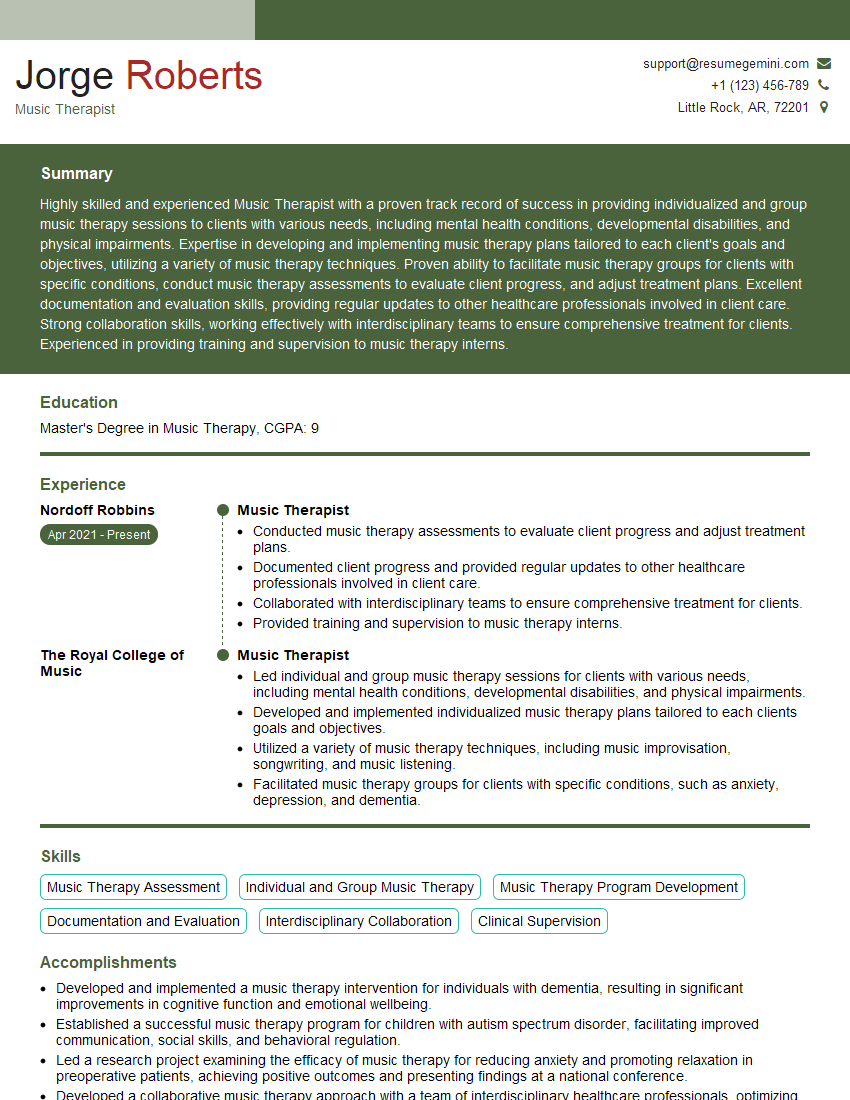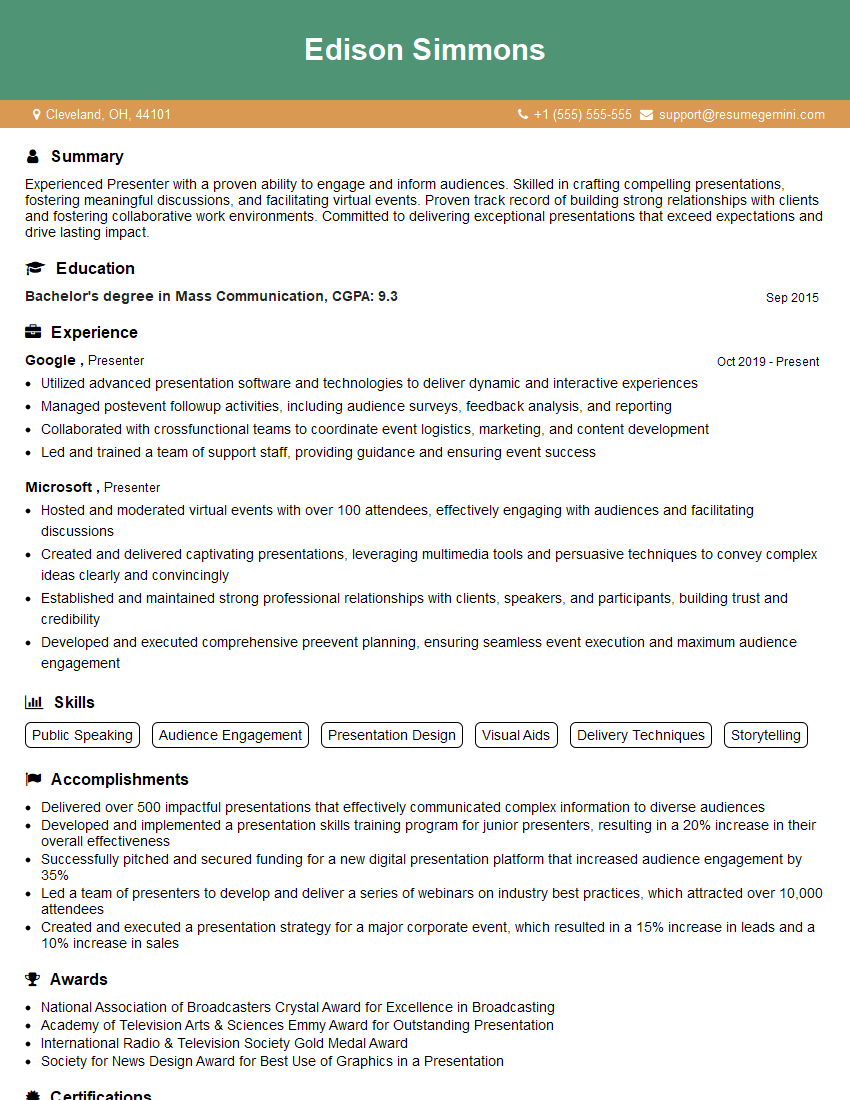Every successful interview starts with knowing what to expect. In this blog, we’ll take you through the top Vocal Projection and Performance interview questions, breaking them down with expert tips to help you deliver impactful answers. Step into your next interview fully prepared and ready to succeed.
Questions Asked in Vocal Projection and Performance Interview
Q 1. Explain the physiological mechanisms behind vocal projection.
Vocal projection, essentially, is the ability to make your voice heard clearly and effectively over distance or background noise. Physiologically, it hinges on several key elements. First, breath support is paramount. A strong, controlled exhale from your diaphragm provides the air pressure needed to vibrate your vocal cords with sufficient force. Second, resonance plays a crucial role. By manipulating the shape of your vocal tract (mouth, throat, nasal cavity), you can amplify certain frequencies, making your voice fuller and richer. Think of it like shaping a sound wave – you’re not just shouting louder, you’re sculpting the sound itself. Third, vocal cord adduction, or how tightly your vocal cords come together, influences the volume and clarity. Proper adduction ensures a clean sound production, reducing breathiness and improving projection. Finally, articulation ensures that your words are clear and understandable, even at a distance. Clear articulation prevents the listener from having to work too hard to decipher the message.
Q 2. Describe different vocal projection techniques for various settings (e.g., intimate vs. large venue).
Vocal projection techniques vary considerably based on the setting. In an intimate setting like a small meeting room or a one-on-one conversation, a softer, more conversational approach suffices. Focus here should be on clear articulation and maintaining good vocal hygiene. You want to be easily heard and understood without straining.
Conversely, in a large venue such as a concert hall or auditorium, you need a significantly more amplified approach. This necessitates deeper breathing, stronger support from your diaphragm, and careful management of resonance. You might find yourself naturally using more open vowels and employing techniques to direct your vocal energy towards the audience.
Outdoor spaces present unique challenges. Wind, distance, and background noise make the need for powerful breath support and precise articulation even more pronounced. Consider the use of microphones in large outdoor events.
In each instance, adaptability is key. Listening to your environment and adjusting your technique is a critical skill for successful vocal projection.
Q 3. How do you adapt your vocal projection for different microphone types?
Microphone technique is crucial for effective vocal projection. Different microphone types require different approaches. Dynamic microphones, known for their robustness, often require a slightly more forceful vocal delivery as they are less sensitive. You might need to project your voice slightly more than you would into a sensitive condenser mic.
Condenser microphones, conversely, are highly sensitive. These pick up subtle nuances but can easily become overwhelmed by loud, close-range projection. Using a condenser mic requires a gentler approach, maintaining excellent technique to ensure a clean and unclipped sound. Distance from the microphone is key; too close can lead to distortion, while too far results in a weak signal.
Handheld versus lavalier (clip-on) microphones also require distinct techniques. A handheld microphone allows more dynamic control, providing flexibility in adjusting distance and volume during performance. Lavalier microphones require a more consistent projection as they’re fixed in position.
Regardless of the microphone type, practice and awareness are key. Rehearse with your chosen microphone to understand its sensitivity and respond accordingly.
Q 4. What are the common vocal health issues that affect projection, and how can they be prevented?
Several vocal health issues can significantly impact projection. Vocal nodules, caused by overuse or misuse, are benign growths on the vocal cords that can result in hoarseness and reduced vocal power. Laryngitis, an inflammation of the vocal cords, often leads to temporary voice loss or significant weakening. Chronic throat clearing and excessive coughing can irritate the vocal cords, affecting projection. Acid reflux can also cause irritation and inflammation, impacting vocal quality.
Prevention is paramount. Maintaining good hydration, avoiding vocal strain (such as shouting), practicing good breath support, and warming up your voice before any extended vocal use are crucial preventative measures. Regular vocal rest, avoiding irritants like smoke and alcohol, and seeking professional help from a vocal coach or ENT specialist at the first sign of problems are also essential.
Q 5. How do you maintain vocal stamina during prolonged performances or presentations?
Maintaining vocal stamina during extended performances relies on careful planning and execution. Hydration is crucial. Keeping your body well-hydrated is the foundation of good vocal health and stamina. Proper breathing techniques are fundamental to efficient vocal use. Consistent practice of diaphragmatic breathing ensures you’re drawing upon the full capacity of your lungs rather than relying on your throat for support. Incorporating short rest periods throughout a performance, even for only a few seconds, allows the vocal cords to recover. Careful planning of the performance or presentation, including pacing, can minimize vocal strain. Finally, vocal warm-ups and cool-downs are indispensable. These routines are not optional additions; they are necessary protective measures.
Q 6. Explain the importance of breath support in vocal projection.
Breath support is the cornerstone of powerful and sustained vocal projection. It’s not just about taking deep breaths; it’s about using your diaphragm—the large muscle located below your lungs—as the primary engine for your voice. Proper diaphragmatic breathing allows you to control the airflow smoothly and consistently. This ensures that your vocal cords receive a steady stream of air, reducing strain and increasing projection. Think of your diaphragm as a bellows—it provides the controlled pressure needed to produce a powerful, resonant tone without resorting to strain or shouting. Imagine trying to blow up a balloon with just your chest muscles vs. using your diaphragm – the difference in power and control is striking. This controlled pressure provides the foundation for your voice’s volume and power without tension in your throat or neck.
Q 7. Describe your experience with vocal warm-up exercises and their benefits.
Vocal warm-up exercises are essential for preparing your voice for performance and preventing injury. My warm-up routine typically includes a series of exercises focusing on breathing, range, and articulation. Humming on different pitches helps to gently warm up the vocal cords. Lip trills and tongue trills loosen the muscles in the mouth and throat, promoting flexibility and reducing tension. Scales and arpeggios help to extend and strengthen the vocal range. Articulation exercises, such as tongue twisters, improve clarity and precision of speech.
The benefits are substantial: Warm-ups improve vocal range, reduce strain, increase flexibility, and enhance projection. They prepare the vocal cords for the demands of performance, minimizing the risk of injury or vocal fatigue. It’s like stretching before a workout—a crucial element for optimal performance and injury prevention.
Q 8. How do you use resonance to enhance vocal projection?
Resonance is the key to powerful and effortless vocal projection. It’s the amplification of your voice through the natural resonating chambers in your head, chest, and throat. Think of it like this: your vocal cords produce the sound, but resonance shapes and amplifies it. To enhance projection using resonance, we focus on directing the sound into these spaces.
For example, feeling a vibration in your chest (chest resonance) during speech indicates effective use of your lower resonating chambers, adding power and depth to your voice. Similarly, feeling a vibration in the mask of your face (mask resonance), encompassing your nasal cavity and sinuses, contributes to clarity and projection, especially for higher notes. Effective vocal projection isn’t about shouting; it’s about using the body’s natural amplifiers.
We achieve this through targeted exercises that train the singer to feel and control the placement of sound within these resonant spaces. This often involves humming and exploring various vowel sounds, gradually increasing volume while maintaining control and avoiding strain. A skilled teacher can guide you to find your optimal resonance points, tailored to your unique vocal anatomy.
Q 9. How do you manage vocal fatigue and recovery?
Vocal fatigue is a serious concern for singers and speakers alike. It’s often caused by misuse of vocal technique, dehydration, or excessive strain. Management involves a multifaceted approach encompassing prevention and recovery.
- Prevention: Proper breathing techniques, maintaining good hydration (drinking plenty of water), avoiding excessive talking or singing, especially when tired, and employing efficient vocal techniques are crucial.
- Recovery: Rest is paramount. This includes vocal rest, avoiding whispering (which can be more straining than speaking), and getting adequate sleep. Gentle vocal exercises focused on relaxation, such as humming or lip trills, can help to restore vocal flexibility without causing further fatigue. In cases of persistent issues, seeking advice from a qualified vocal therapist is important.
I’ve seen many students overcome vocal fatigue by focusing on these strategies. For example, one student struggling with chronic hoarseness learned to implement proper breathing support and hydration, dramatically improving their vocal health and endurance.
Q 10. What strategies do you employ to project your voice while maintaining clarity and articulation?
Projecting your voice clearly requires a balance of power and precision. Simply increasing volume without proper technique results in strained, unclear speech. Effective strategies focus on breath support, articulation, and resonance.
- Breath Support: Sufficient breath from the diaphragm provides the foundation for consistent projection. Think of it as the fuel for your voice.
- Articulation: Precise movement of the tongue, lips, and jaw creates clear consonant sounds. Exercises like tongue twisters can improve dexterity and clarity.
- Resonance (as discussed earlier): Utilizing the body’s natural resonators amplifies the voice without strain, improving both power and clarity.
A practical example: I often work with public speakers who need to command attention in large rooms. We focus on proper breathing, articulating each word with intention, and using resonance to fill the space, ensuring that even listeners in the back rows can understand every word.
Q 11. Explain the relationship between posture and vocal projection.
Posture plays a pivotal role in vocal projection. An upright, relaxed posture allows for optimal breath support and resonance. Poor posture restricts breathing, leading to strained voice and reduced projection.
- Optimal Posture: Imagine a string pulling you up from the crown of your head. Your shoulders should be relaxed, your spine straight but not rigid, and your feet comfortably planted.
- Impact of Poor Posture: Slouching compresses the lungs and restricts airflow, resulting in weaker vocal projection and potential strain on the vocal cords. Conversely, standing tall opens the chest cavity, enabling fuller breaths and improved vocal resonance.
Think of a singer trying to hit high notes while hunched over – it’s extremely challenging. Good posture allows for free flow of breath, enabling the singer to achieve a powerful and resonant sound.
Q 12. How do you assess an individual’s vocal needs and create a customized training plan?
Assessing an individual’s vocal needs involves a thorough evaluation process. This includes:
- Vocal Assessment: Listening to their speaking and singing voice, analyzing their vocal range, tone, and breath support. I look for any signs of strain, tension, or vocal irregularities.
- Lifestyle Assessment: Understanding their daily vocal demands, any underlying health conditions, and current habits (hydration, smoking, etc.).
- Goal Setting: Collaboratively defining their specific objectives—whether it’s improving public speaking skills, singing ability, or managing vocal health issues.
Based on this evaluation, I create a customized training plan encompassing specific exercises and techniques tailored to their individual needs and goals. This ensures they receive the most effective and efficient training, maximizing their potential while avoiding potential harm.
Q 13. Describe your experience with different vocal styles and techniques.
My experience spans a wide range of vocal styles and techniques. I’ve worked with individuals from diverse backgrounds and skill levels. This includes classical singers, musical theater performers, public speakers, and even those seeking to improve everyday communication skills.
My training encompasses various methodologies, including classical vocal techniques, contemporary vocal methods, speech-level singing, and the Alexander Technique (for postural alignment). This diverse experience enables me to adapt my teaching approach to suit individual learning styles and preferences. For example, I might employ a more structured approach for classical singers, while focusing on practical application and immediate results for public speakers.
Q 14. How do you handle unexpected vocal challenges during a performance?
Unexpected vocal challenges during a performance are unfortunately common. My approach focuses on preparedness and quick problem-solving. Prior to a performance, I always ensure adequate rest and hydration. I also have a prepared ‘vocal first-aid kit’ that may include things such as warm water with honey and lemon (if appropriate), throat lozenges, and a reliable backup plan.
During a performance, if a vocal issue arises, my response depends on the severity. For minor issues like a slight dryness, I may implement simple vocal exercises to improve hydration. For more significant challenges, I may need to adjust the performance, simplifying phrasing or slowing tempo to manage the issue. A well-practiced performance allows flexibility for such adaptations. In severe cases, where vocal health is at risk, I wouldn’t hesitate to postpone the performance to ensure vocal recovery.
Q 15. How do you incorporate vocal projection techniques into public speaking?
Incorporating vocal projection techniques into public speaking is crucial for ensuring your message is heard and understood. It’s not just about shouting; it’s about efficient breath support, clear articulation, and resonance.
- Breath Support: Think of your breath as the foundation of your voice. Diaphragmatic breathing, engaging your core muscles, provides the power needed for projection. Imagine blowing up a balloon – that controlled, deep breath is what you want to replicate.
- Posture: Stand tall with good posture. A slumped posture restricts your breath and limits resonance. Think of a singer standing tall on stage; that posture enhances their sound.
- Resonance: This involves using the natural chambers in your body (chest, head, and mask) to amplify your sound naturally. Instead of forcing volume, learn to direct your sound into these resonating spaces. It’s like using a megaphone, but one built into your body.
- Articulation: Enunciate clearly. Mumbling or rushing words obscures your message. Imagine a news anchor; clear articulation is paramount.
- Practice: Regular practice is key. Practice speaking aloud, focusing on these techniques, in different environments to build confidence and control.
For example, a lawyer delivering a closing argument needs to project their voice to the jury and judge effectively. A teacher lecturing a large class needs their voice to reach all students clearly.
Career Expert Tips:
- Ace those interviews! Prepare effectively by reviewing the Top 50 Most Common Interview Questions on ResumeGemini.
- Navigate your job search with confidence! Explore a wide range of Career Tips on ResumeGemini. Learn about common challenges and recommendations to overcome them.
- Craft the perfect resume! Master the Art of Resume Writing with ResumeGemini’s guide. Showcase your unique qualifications and achievements effectively.
- Don’t miss out on holiday savings! Build your dream resume with ResumeGemini’s ATS optimized templates.
Q 16. How do you ensure your vocal performance is engaging and impactful?
Engaging and impactful vocal performance relies on more than just projection; it’s a blend of vocal technique and performance artistry.
- Vocal Variety: Vary your pace, pitch, and volume to keep your audience engaged. A monotone voice is quickly fatiguing. Think of a storyteller – they modulate their voice to evoke different emotions and keep listeners captivated.
- Emotional Connection: Connect emotionally with your material. Authenticity resonates more powerfully than rote delivery. Imagine a singer pouring their heart into a ballad – that emotional depth is contagious.
- Storytelling: Structure your speech or song as a narrative, drawing the audience into the story. Human beings are wired to respond to stories.
- Pause and Emphasis: Strategic pauses and emphasis on key words amplify your message’s impact. Think of a politician delivering a powerful speech – pauses add weight to their words.
- Eye Contact: Connecting visually with your audience establishes rapport and strengthens your message’s impact. It helps to ensure that your performance isn’t just a monologue.
For instance, a motivational speaker needs to ignite passion and inspire action. A musical performer needs to convey the emotions of the song to connect with the audience.
Q 17. Explain the importance of audience engagement in vocal performance.
Audience engagement is paramount in vocal performance because it creates a feedback loop that enhances the experience for both performer and audience. A disengaged audience is a silent wall; an engaged audience is a vibrant partner in the performance.
- Shared Experience: Engagement fosters a shared experience, creating a sense of community and connection. It makes the performance memorable.
- Increased Impact: An engaged audience is more receptive to the message, increasing the impact of the performance. A captivated listener is a listener who understands and remembers.
- Performance Enhancement: Audience response provides valuable feedback to the performer, allowing for adjustments and improvements. It’s like a live instrument tuning itself to the room.
- Positive Energy: A responsive audience generates positive energy, boosting the performer’s confidence and enhancing the overall quality of the performance.
Think of a comedian – their performance thrives on audience laughter and participation. A choir’s performance depends on unified engagement and energy to create a compelling sound.
Q 18. Describe your method for analyzing vocal performance recordings.
Analyzing vocal performance recordings involves a multi-faceted approach, focusing on both technical and artistic aspects.
- Technical Aspects: I listen for breath support, resonance, vocal quality (tone, timbre), articulation, and intonation. Are there any areas where the breath support is weak? Is the resonance full or thin? Are words clearly articulated?
- Artistic Aspects: I assess the performance’s emotional impact, pacing, dynamics (variation in volume and intensity), and overall expressiveness. Does the performance evoke the desired emotions? Is the pacing engaging? Are there effective dynamic contrasts?
- Software Tools: Software such as Audacity or specialized vocal analysis programs can help visualize aspects like pitch and volume changes, providing a quantifiable view of the performance. This assists with more objective analysis.
- Repeated Listening: I employ repeated listening to identify patterns and nuances that might be missed on first pass.
For example, a singer might have beautiful tone but poor breath control, impacting their ability to sustain notes. A speaker might be clear but lack emotional connection, diminishing their message’s power. The recording helps pinpoint these specific areas for improvement.
Q 19. How do you provide constructive feedback to singers or speakers?
Providing constructive feedback requires sensitivity and a focus on specific, actionable suggestions rather than generalized criticism.
- Positive Reinforcement: I always start by highlighting the strengths of the performance before addressing areas for improvement. This establishes a positive and receptive environment.
- Specificity: Instead of vague comments like “your voice was weak,” I provide specific examples: “At the 30-second mark, your breath support seemed to falter, causing a slight weakening in the sound. Try engaging your diaphragm more deeply there.”
- Actionable Suggestions: I focus on offering concrete steps for improvement. “Try practicing diaphragmatic breathing exercises daily to improve your breath support,” or “experiment with varying your pace slightly to increase the audience’s engagement.”
- Contextualized Feedback: My feedback always considers the context of the performance – the genre, the setting, the audience. What worked well in one context might not in another.
- Encouragement and Support: I emphasize a growth mindset, focusing on the potential for improvement and offering encouragement to foster continued learning and development.
For example, I might suggest a specific vocal exercise to address a singer’s breath control issues or suggest a different phrasing technique to enhance a speaker’s message delivery.
Q 20. Explain the differences between singing and speaking techniques in terms of vocal projection.
While both singing and speaking involve vocal projection, the techniques differ significantly due to their distinct goals.
- Pitch and Range: Singing requires a much wider pitch range and more precise control over pitch accuracy compared to speaking. Singers use their entire vocal range, while speakers primarily work within a narrower speaking range.
- Vocal Production: Singing often involves the production of sustained notes and complex melodies, requiring more sophisticated breath control and vocal cord coordination than speaking. Singers need to maintain precise and controlled airflow for long notes.
- Resonance: Singers often emphasize different resonance techniques to achieve various timbres and tonal qualities, while speakers primarily focus on clear and effective projection.
- Articulation and Diction: While both require clear articulation, singers often employ more refined diction techniques to meet the demands of singing specific lyrics.
- Dynamic Range: Singers typically work with a larger dynamic range – the difference between loud and soft – than speakers. They might use a crescendo or diminuendo to enhance their performance, something less common in regular speech.
A singer might utilize vibrato (a slight trembling of the voice) to add expression, a technique not typically used in speaking. A speaker focuses on clear and concise delivery to maintain audience engagement; a singer might prioritize emotional expression over strictly literal communication.
Q 21. What are the common vocal issues encountered in different age groups?
Different age groups encounter unique vocal challenges.
- Children: Children’s vocal cords are still developing, making them susceptible to vocal fatigue and misuse. They might have difficulty controlling their volume or pitch accurately.
- Teenagers: Hormonal changes during puberty can affect voice quality and range, leading to voice breaks or inconsistencies. Vocal strain from excessive shouting or singing is also common.
- Adults (20-60): Adults might experience vocal issues related to lifestyle factors such as smoking, excessive alcohol consumption, and vocal strain from prolonged speaking or singing. Vocal nodules or polyps are possibilities.
- Older Adults (60+): Age-related changes in vocal cord structure and function can cause changes in voice quality (e.g., hoarseness, tremor), reduced range, and weaker projection. This may be linked to issues like arthritis affecting breathing and vocal muscles.
Addressing these issues often involves vocal rest, hydration, vocal therapy, and lifestyle modifications. Early intervention is crucial in preventing long-term vocal damage.
Q 22. Describe your experience working with individuals who have vocal disorders.
My experience with individuals having vocal disorders spans several years and includes working with clients exhibiting a range of conditions, from vocal nodules and polyps to dysphonia and spasmodic dysphonia. My approach is always holistic, focusing not just on the immediate vocal issue but also on the underlying causes which might include incorrect vocal technique, stress, or even medical conditions.
For instance, I worked with a singer who developed vocal nodules due to improper breath support. We started by addressing her breathing technique using exercises focusing on diaphragmatic breathing and controlled exhalation. We also incorporated techniques like gentle humming and lip trills to improve vocal fold coordination. Alongside these exercises, we discussed stress management techniques and vocal rest protocols. The combination of addressing the technical aspects and the emotional stress factors was crucial in her recovery. Each case is unique and requires a personalized treatment plan, often involving close collaboration with other medical professionals like ENT specialists and speech-language pathologists.
Another example involves a teacher with spasmodic dysphonia. This is a neurological condition that affects the vocal cords, leading to involuntary spasms and breaks in speech. For this client, we focused on strategies for managing the spasms, such as relaxation techniques, controlled breathing, and speech therapy exercises focusing on reducing vocal effort. Success in such cases often relies on ongoing support and adapting strategies based on the client’s progress and feedback.
Q 23. How do you adapt your teaching methods for different learning styles?
Adapting my teaching to different learning styles is paramount. I believe in employing a multimodal approach, catering to visual, auditory, and kinesthetic learners. For visual learners, I use diagrams, charts, and videos demonstrating proper vocal techniques. Auditory learners benefit from clear explanations, audio examples of correct and incorrect vocal production, and listening exercises.
Kinesthetic learners, who learn best through physical activity, engage in hands-on exercises like breathing exercises, tongue and jaw relaxation techniques, and physical postures that enhance vocal resonance. For example, I might use physical imagery like ‘feeling the breath flow down to the diaphragm’ to help visualize proper breathing technique. I also regularly assess their progress through observation and incorporate their feedback to ensure the method resonates with them. Regular feedback sessions, allowing them to ask questions and practice techniques, are vital for refining their understanding.
Furthermore, I integrate various teaching strategies such as storytelling, analogies, and gamification to keep learning fun and engaging, regardless of learning style.
Q 24. What software or technology do you use to enhance vocal performance?
Technology plays a significant role in enhancing vocal performance. I regularly use software like Audacity for audio recording and analysis. This allows clients to listen back to their vocal performance, identifying areas for improvement in pitch, tone, and articulation. We can analyze the recordings together to pinpoint specific aspects needing refinement, offering immediate, concrete feedback.
I also utilize spectral analysis software to visualize vocal patterns, providing a visual representation of their voice’s frequency and amplitude. This gives insightful data on vocal health and helps identify potential issues like vocal fry or excessive strain. Furthermore, video recording allows for detailed analysis of posture, facial expressions, and body language, ensuring effective communication and performance.
Moreover, I leverage online resources like vocal training apps and websites to supplement in-person lessons with additional practice opportunities and personalized exercises. The use of technology in this way allows me to offer highly customized and effective vocal training to my clients.
Q 25. Describe a time you had to overcome a vocal challenge.
One memorable vocal challenge involved preparing for a demanding opera performance. I was recovering from a slight cold and my voice was noticeably weaker than usual. It was a critical performance, and there was significant pressure. My initial instinct was to push through, which would have likely exacerbated the issue.
Instead, I adopted a conservative approach. I prioritized vocal rest, staying hydrated, and incorporating gentle vocal exercises to keep the vocal folds lubricated without strain. I focused on efficient breathing techniques to maximize vocal production while minimizing effort. I worked closely with my vocal coach, adapting the performance strategies to suit my current vocal limitations. We modified some high-intensity passages and explored techniques to project my voice effectively even with reduced power. On the performance night, while not at my absolute peak, I delivered a successful performance largely due to the preparedness and sensible decisions made in the preceding days.
Q 26. How do you create a dynamic and expressive vocal delivery?
Creating a dynamic and expressive vocal delivery involves a multifaceted approach. It’s about more than just the sound; it’s about conveying emotion and engaging the audience. First, understanding the text is crucial. This involves analyzing the meaning, intent, and emotion behind the words. This understanding forms the foundation for conveying emotion effectively.
Next, manipulating various vocal elements plays a vital role. These include pacing, rhythm, pitch variation (intonation), and dynamics (loudness and softness). For instance, a slow pace with a low pitch might convey sadness, while a faster pace with a higher pitch and increased volume can express excitement. Pauses are equally important for creating emphasis and allowing the audience to process information. Using appropriate phrasing helps group words together and create a natural flow.
Finally, physical expression is paramount. Body language, facial expressions, and eye contact enhance the vocal delivery by providing a visual component that supports the emotional message. The combination of well-controlled vocal techniques and expressive physicality allows a speaker or performer to establish a powerful connection with their audience, leading to a more dynamic and engaging delivery.
Q 27. What are some effective methods for minimizing vocal strain?
Minimizing vocal strain requires a combination of techniques focused on proper vocal technique and lifestyle choices. First and foremost is proper breathing technique. Utilizing diaphragmatic breathing ensures sufficient air support, reducing the strain on the vocal cords. This involves breathing deeply from the diaphragm, not just the chest, ensuring a steady and controlled airflow.
- Hydration: Drinking plenty of water keeps the vocal cords lubricated, reducing friction and strain.
- Vocal Rest: Giving your voice adequate rest is crucial, especially after extended periods of speaking or singing.
- Posture: Maintaining good posture allows for optimal breath support and resonance.
- Avoid Throat Clearing: Throat clearing can irritate the vocal cords. Instead, try gently swallowing or sipping water.
- Avoid Smoking and Alcohol: These substances can dry out the vocal cords and irritate the throat.
Regular vocal exercises, like humming and lip trills, warm up the vocal cords and improve muscle coordination. Learning to project your voice effectively, using resonance rather than just volume, reduces strain by optimizing sound production.
Q 28. How do you maintain a healthy vocal routine?
Maintaining a healthy vocal routine is crucial for longevity and performance. My daily routine prioritizes hydration, consuming plenty of water throughout the day to keep my vocal cords lubricated. I incorporate regular vocal warm-ups and cool-downs, usually consisting of gentle humming and lip trills to prepare my voice for speaking or singing and then gradual relaxation exercises afterward.
I focus on maintaining good posture, understanding its direct impact on breath support and vocal production. I regularly practice proper breathing techniques, ensuring the efficient use of my breath without unnecessary strain. I also prioritize vocal rest; when not using my voice professionally, I avoid shouting or whispering and limit prolonged speaking or singing sessions.
Finally, I pay close attention to my overall health through a balanced diet, adequate sleep, and regular exercise. These all contribute to overall wellness, indirectly impacting vocal health and performance. Regular checkups with an ENT specialist also help monitor vocal health and address any potential issues promptly.
Key Topics to Learn for Vocal Projection and Performance Interview
- Understanding Vocal Anatomy and Physiology: Learn the mechanics of voice production, including breath control, resonance, and articulation. This foundational knowledge is crucial for explaining your approach to performance.
- Vocal Technique and Exercises: Be prepared to discuss specific techniques you’ve mastered, such as diaphragmatic breathing, vocal warm-ups, and exercises to improve projection and resonance. Illustrate your understanding with practical examples.
- Performance and Stage Presence: Discuss your understanding of audience engagement, microphone technique, and how to adapt your performance to different venues and audiences. Highlight your ability to connect with an audience emotionally.
- Vocal Health and Maintenance: Demonstrate awareness of vocal hygiene, recognizing and addressing potential issues, and incorporating preventative measures into your practice. This showcases professionalism and dedication.
- Interpreting and Communicating Text: Explain how you analyze scripts or musical scores to inform your vocal choices, ensuring clarity, emotion, and effective communication.
- Problem-solving in Performance: Be ready to discuss how you handle unexpected situations during a performance, such as technical difficulties or audience reactions. Show your adaptability and resourcefulness.
- Styles and Genres: Demonstrate familiarity with various performance styles (e.g., musical theatre, opera, public speaking) and how your techniques adapt to each.
Next Steps
Mastering vocal projection and performance is vital for career advancement in numerous fields, from acting and singing to teaching and public speaking. A strong command of these skills opens doors to exciting opportunities and allows you to communicate effectively and powerfully. To maximize your job prospects, crafting a compelling and ATS-friendly resume is essential. ResumeGemini can help you create a professional and impactful resume that highlights your unique skills and experience in vocal projection and performance. Examples of resumes tailored to this field are available, providing you with a valuable resource and inspiration for your own resume creation.
Explore more articles
Users Rating of Our Blogs
Share Your Experience
We value your feedback! Please rate our content and share your thoughts (optional).
What Readers Say About Our Blog
Hello,
We found issues with your domain’s email setup that may be sending your messages to spam or blocking them completely. InboxShield Mini shows you how to fix it in minutes — no tech skills required.
Scan your domain now for details: https://inboxshield-mini.com/
— Adam @ InboxShield Mini
Reply STOP to unsubscribe
Hi, are you owner of interviewgemini.com? What if I told you I could help you find extra time in your schedule, reconnect with leads you didn’t even realize you missed, and bring in more “I want to work with you” conversations, without increasing your ad spend or hiring a full-time employee?
All with a flexible, budget-friendly service that could easily pay for itself. Sounds good?
Would it be nice to jump on a quick 10-minute call so I can show you exactly how we make this work?
Best,
Hapei
Marketing Director
Hey, I know you’re the owner of interviewgemini.com. I’ll be quick.
Fundraising for your business is tough and time-consuming. We make it easier by guaranteeing two private investor meetings each month, for six months. No demos, no pitch events – just direct introductions to active investors matched to your startup.
If youR17;re raising, this could help you build real momentum. Want me to send more info?
Hi, I represent an SEO company that specialises in getting you AI citations and higher rankings on Google. I’d like to offer you a 100% free SEO audit for your website. Would you be interested?
Hi, I represent an SEO company that specialises in getting you AI citations and higher rankings on Google. I’d like to offer you a 100% free SEO audit for your website. Would you be interested?
good


